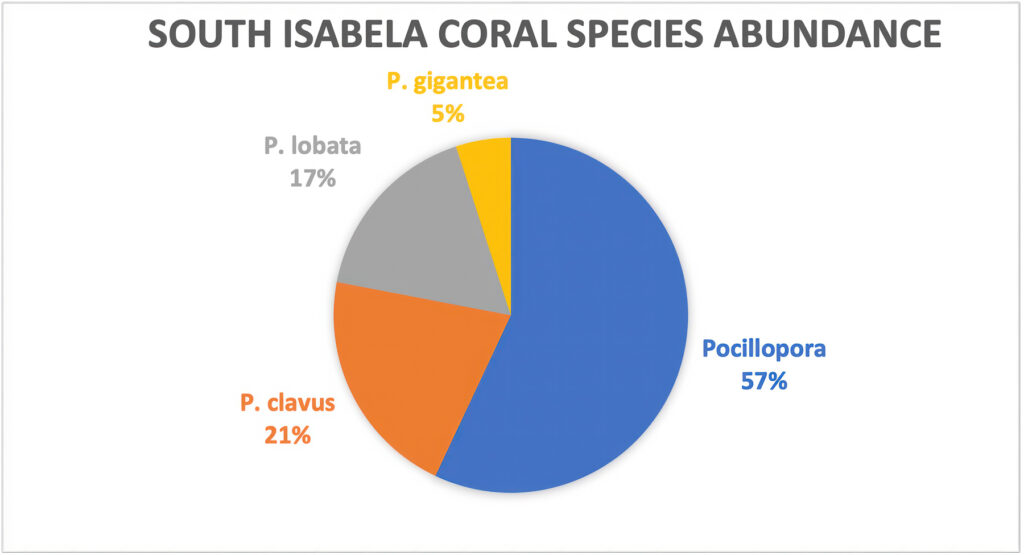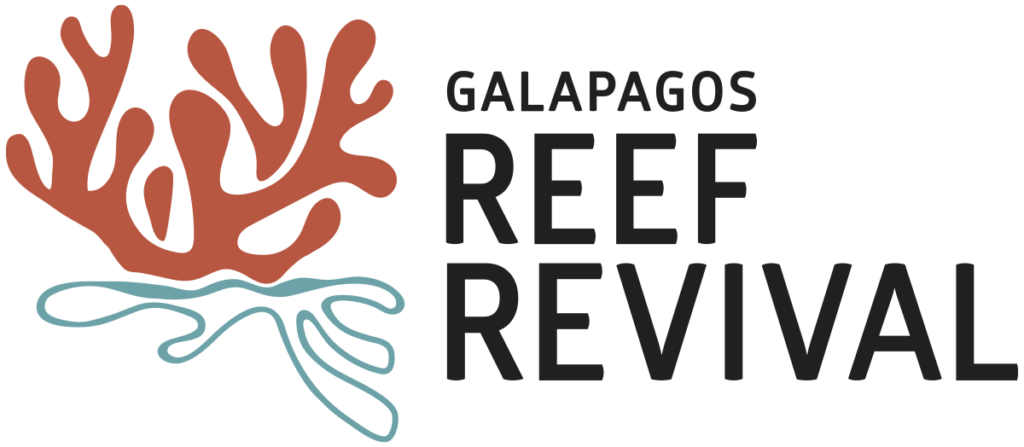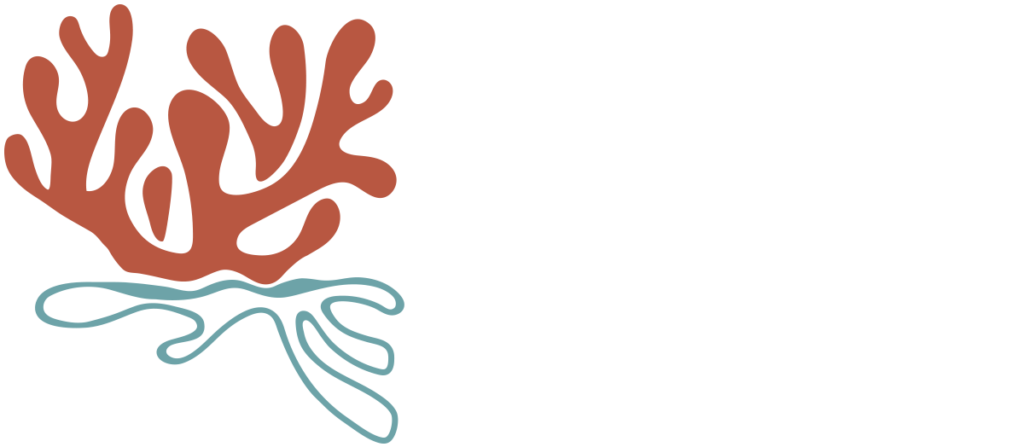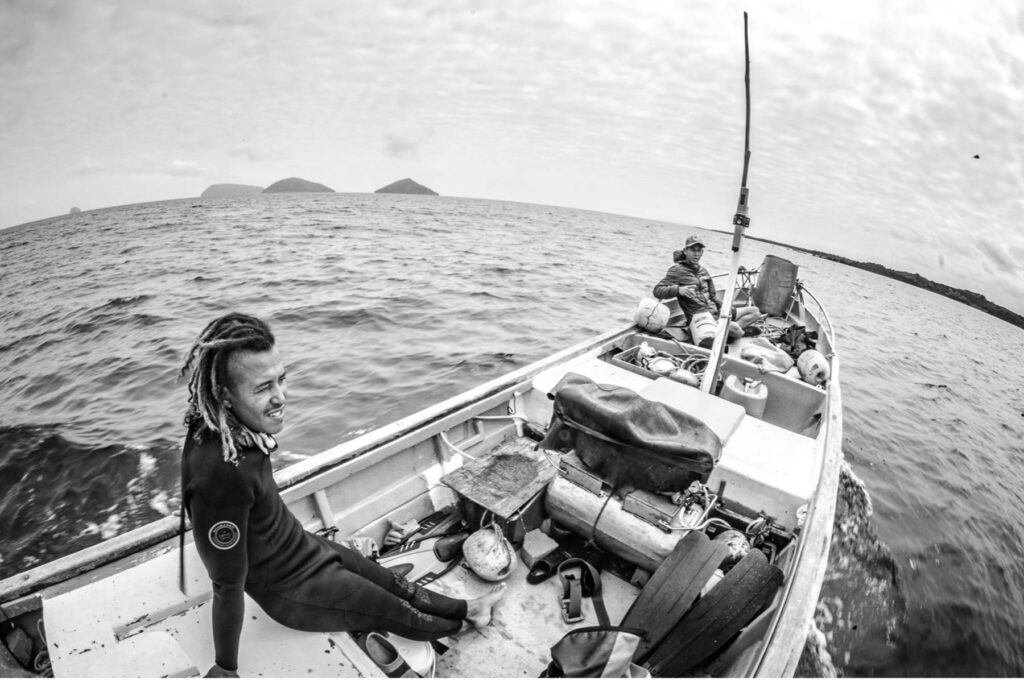Coral species such as Pocillopora have shown relatively low diversity in Puerto Villamil Bay. Since these are considered a fundamental part of the restoration process, our team has focused its efforts on finding new coral populations outside the bay area in order to integrate new varieties and increase the coral nursery representation.
Methods
Our team undertook several expeditions, to explore the most suitable areas in southern Isabela rugged coastline. Visited sites included Lobería Chica, Lobería Grande, Estero del Mangle, Bahia Hortensia, Lumaveda and Tortuga Island, most of which have led to the discovery and characterization of previous undescribed populations. The charted coral remnants provided a fresh source of coral fragments, which we collected and carefully transported to our nursery in Pto. Villamil. The exploratory trips have allowed the project to substantially increase our coral diversity and capacity with over 2500 fragments from more than 50 different coral varieties.
Results
Exploratory missions outside the area of Puerto Villamil were undertaken mostly in the southeastern coastline of Isabela island in the areas of infered coral presence. Our overall exploration of 6 sites yielded a total of 777 colonies of hermatypic corals divided between three different genus. The most abundant group was Pocillopora (57%), due to its fragmentation and asexual reproduction capacity, followed by P. clavus (21%), P. lobata (17%) and P. gigantea (5%). The areas sampled had lower general diversity of coral species than Puerto Villamil, although with a higher intraspecific richness of Pocillopora varieties.

Loberia Chica
Our first visit took place in Loberia Chica, a small congregation of islets and rocky outcrops just south of Puerto Villamil. Loberia Chica once hosted one of the largest historical coral reef in the islands, an area that spanned more than 7 hectares and connected with La Calera reef in Puerto Villamil. The area counts with irrevocable proof of the sheer richness and extense of this extinct coral ecosystem. Nevertheless, our team was surprised to find a diminished diversity and limited surviving remnants. Loberia Chica did not yield one single Pocillopora colony (regardless of extensive evidence of branching coral skeletons), but hosted a significant population of Porites and Pavona, mostly present in the exposed sections of the islets.
Hortensia
Towards the northeast, lies Hortensia, a small bay a few kilometers east of Puerto Villami protected by the shallow sandy bottom and the southern islets of Loberia Chica. The bay proved to be rather poor, with only two coral varieties, although one of them was highly abundant. Sheltered deep within the bay our team found a monogenotypic community of Pocillopora which comprised at least 150 colonies, all product of asexual reproduction from fragmentation. Non surprisingly, this is one of the most fragile corals in our nursery, but also one with the highest growth rates.
El Faro
It seems that fragmentation may be the only resource left for marginal coral survivors in Galapagos. Just like in Hortensia, the rocky peninsula that extends in the long beach outside Puerto Villamil, commonly known as El Faro hosts a remarkable monogenotipic population of asexual origin. Although composed of a single morphospecies, it is clearly a surviving colonly of what once was a small coral reef. The intense waves and sandy bottom of the area create less than ideal conditions for coral growth, but the peninsula hosts a rocky outcrop with clear signs of past reef structure. The single coral variety found was highly abundant, easily exceeding 80 colonies, yet in less than ideal health due to the high sedimentation.
Loberia Grande
Loberia Grande is a rocky bay that lies amid the waves. This site, not to be confused with Loberia Chica, which lies 4km west, hosts a completely different geography and marine conditions. The bay faces directly south, with a sharp drop in depth just a few hundred meters from the coast, creating strong currents and colder water temperatures. The bay had limited coral abundance, represented by small Pocillopora colonies, product of their recent recruitment in the area. Surprisingly, our team found an extensive Porites and Pavona patch in a rocky drop facing open waters, constituting an entire section of the bay and creating a insipient reef resambling exposed sections of Loberia Chica.
Tortuga
Tortuga island is a large collapsed volcano directly south of Puerto Villamil. Its shallow shelves seem ideal for coral settlement, yet the depth surrounding the island crate substantial upwelling of deep cold-water currents, drastically droping water temperatures and reducing coral survival. Nevertheless, our exploration proved to be more successful than expected. The eastern coast of the island contained a small shelf with a high diversity of corals, although in relative low abundance. The team was able to identify 10 different Pocillopora varieties, and several Porties and Pavona, mostly small sized recruits. There seems to be a common trend with higher abundance of corals appearing in the east facing coastlines, which Tortuga island proved to be right.
Lumaveda
Our furthest expedition took place in the rocky shores of Lumaveda, an assamble of small rocky bays and peninsulas that slowly submerge towards the east creating a shallow basalt shelf. The area bares the name of a ship wreck that happened back in the 90s due to the shallow seabed. The area is seldomly visited by lobster fisherman, and it has non existant studies, making its coral community a complete mystery. Our team ventured to the area due to fisherman rumors attesting to coral presence. The wavy shores of this rugged coastline had fairly scattered coral composition, consisting mostly of recent recruits of Pocillopora on its most exposed sections. Surprisingly the area revealed extensive Porites presence in the protected bays, demonstrating possibly decades (possibly centuries) of sustained coral growth. On these shallow bays we encountered some the largest Porites individuals in Isabela, although they showed substantial bleachinig and tissue death, most possibly due to cold-water bleaching after 2022 la Niña. The area yielded a substantial diversity of corals, including 8 morphospecies of Pocillopora and several more of Porites, although Pavona species proved scarce.
Not all our missions end up with positive results. Our team has carried explorations in other sites of the archipealgo which have proven completely unsuccessful. Such is the case of Estero del Mangle. Seemingly an ideal locality, Estero yielded no more than one single Porites coral, and no evidence of past coral cover.


